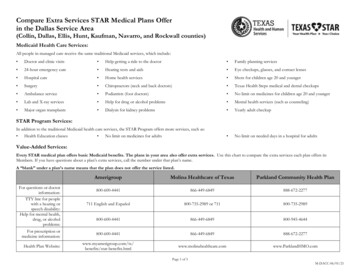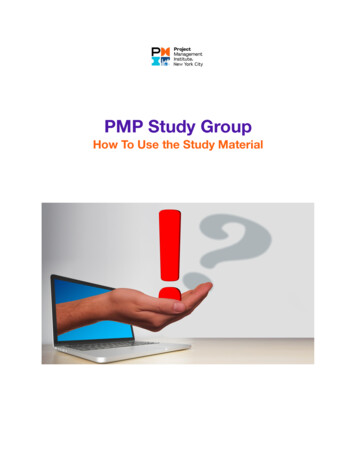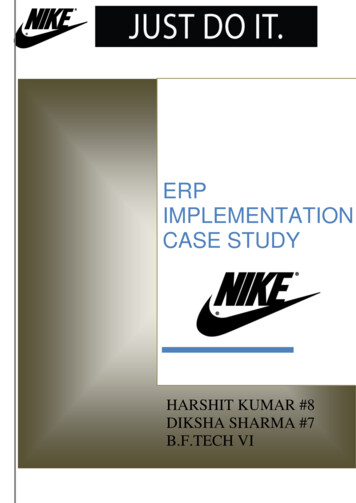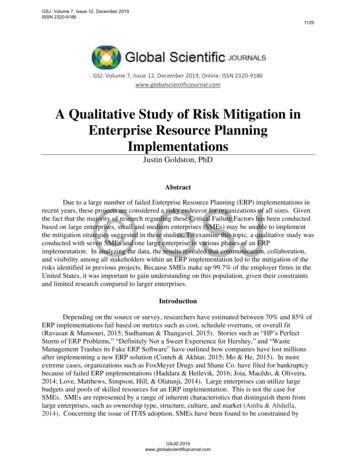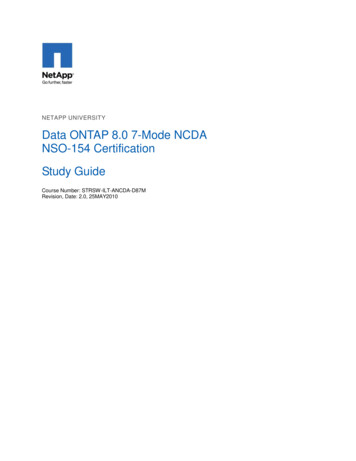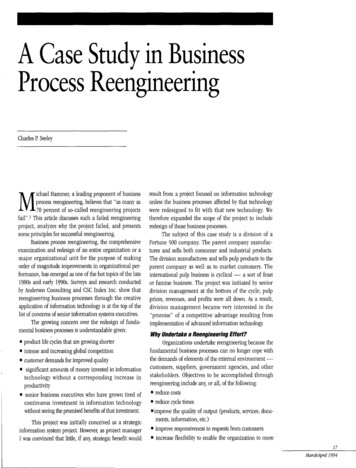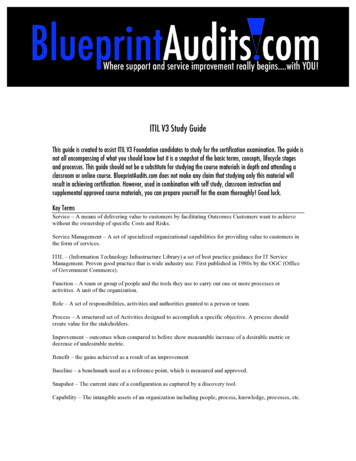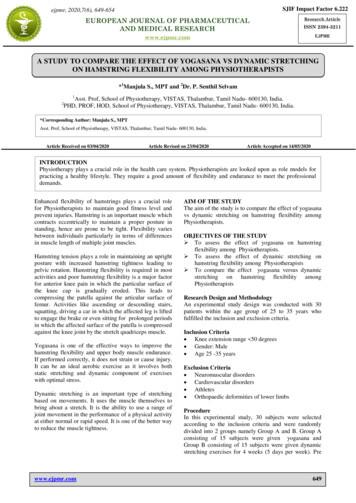
Transcription
SJIF Impact Factor 6.222ejpmr, 2020,7(6), 649-654Research ArticleEUROPEAN JOURNAL OF PHARMACEUTICALEuropean Journal of Pharmaceutical and Medical ResearchISSN2394-3211AND MEDICAL RESEARCHManjula et al.EJPMRwww.ejpmr.comA STUDY TO COMPARE THE EFFECT OF YOGASANA VS DYNAMIC STRETCHINGON HAMSTRING FLEXIBILITY AMONG PHYSIOTHERAPISTS*1Manjula S., MPT and 2Dr. P. Senthil Selvam12Asst. Prof, School of Physiotherapy, VISTAS, Thalambur, Tamil Nadu- 600130, India.PHD, PROF, HOD, School of Physiotherapy, VISTAS, Thalambur, Tamil Nadu- 600130, India.*Corresponding Author: Manjula S., MPTAsst. Prof, School of Physiotherapy, VISTAS, Thalambur, Tamil Nadu- 600130, India.Article Received on 03/04/2020Article Revised on 23/04/2020Article Accepted on 14/05/2020INTRODUCTIONPhysiotherapy plays a crucial role in the health care system. Physiotherapists are looked upon as role models forpracticing a healthy lifestyle. They require a good amount of flexibility and endurance to meet the professionaldemands.Enhanced flexibility of hamstrings plays a crucial rolefor Physiotherapists to maintain good fitness level andprevent injuries. Hamstring is an important muscle whichcontracts eccentrically to maintain a proper posture instanding, hence are prone to be tight. Flexibility variesbetween individuals particularly in terms of differencesin muscle length of multiple joint muscles.Hamstring tension plays a role in maintaining an uprightposture with increased hamstring tightness leading topelvic rotation. Hamstring flexibility is required in mostactivities and poor hamstring flexibility is a major factorfor anterior knee pain in which the particular surface ofthe knee cap is gradually eroded. This leads tocompressing the patella against the articular surface offemur. Activities like ascending or descending stairs,squatting, driving a car in which the affected leg is liftedto engage the brake or even sitting for prolonged periodsin which the affected surface of the patella is compressedagainst the knee joint by the stretch quadriceps muscle.Yogasana is one of the effective ways to improve thehamstring flexibility and upper body muscle endurance.If performed correctly, it does not strain or cause injury.It can be an ideal aerobic exercise as it involves bothstatic stretching and dynamic component of exerciseswith optimal stress.Dynamic stretching is an important type of stretchingbased on movements. It uses the muscle themselves tobring about a stretch. It is the ability to use a range ofjoint movement in the performance of a physical activityat either normal or rapid speed. It is one of the better wayto reduce the muscle tightness.www.ejpmr.comAIM OF THE STUDYThe aim of the study is to compare the effect of yogasanavs dynamic stretching on hamstring flexibility amongPhysiotherapists.OBJECTIVES OF THE STUDY To assess the effect of yogasana on hamstringflexibility among Physiotherapists. To assess the effect of dynamic stretching onhamstring flexibility among Physiotherapists To compare the effect yogasana versus dynamicstretching on hamstring flexibility amongPhysiotherapistsResearch Design and MethodologyAn experimental study design was conducted with 30patients within the age group of 25 to 35 years whofulfilled the inclusion and exclusion criteria.Inclusion Criteria Knee extension range 50 degrees Gender: Male Age 25 -35 yearsExclusion Criteria Neuromuscular disorders Cardiovascular disorders Athletes Orthopaedic deformities of lower limbsProcedureIn this experimental study, 30 subjects were selectedaccording to the inclusion criteria and were randomlydivided into 2 groups namely Group A and B. Group Aconsisting of 15 subjects were given yogasana andGroup B consisting of 15 subjects were given dynamicstretching exercises for 4 weeks (5 days per week). Pre649
Manjula et al.European Journal of Pharmaceutical and Medical Researchand post-test assessment was done using active kneeextension test in terms of ROM and sit and reach test.Both yogasana and dynamic stretches should start with awarm up and each section should end with a cool downtime.In yogasana, the procedures should be wellexplained to the subjects. The subjects should perform 15yogasanas in 1 session and each pose was held for 5seconds. A cool down of 1 min followed each session.Hence 1 cycle of yogasana lasted for 90 seconds. Indynamic stretching, each set consisting of 8 exerciseslasted for 1 minute which is inclusive of both the limbs.(30 sec for each limb). The total duration is 8 minutes,and cool down of 2 minutes. The total duration of boththe protocol is 16 minutes.Data AnalysisThe collected pre and post test data were analysed andtabulated. For the descriptive statistics, the mean andstandard deviation were calculated. The results weretabulated and the graphs were plotted accordingly.Testing The Effect of Group A In Assessing TheValue of Rom Knee and Sit & Reach TestH0: There is no significant effect of Treatment A inincreasing the value of ROM KNEE and SIT & REACHTEST ScoreH1: There is significant effect of Treatment A indecreasing the value of ROM KNEE and SIT &REACH TEST Score.The above hypothesis is tested by the use of Paired Sample t-test and the corresponding output is shown below:Table 1: Group A Output of Paired t-test.Mean SD t Stat P(T t) one-tail44.73 3.33 -5.600.000A ROM KNEE R Pre146.93 3.39A ROM KNEE R Post1www.ejpmr.comA ROM KNEE R Pre2A ROM KNEE R Post2Mean46.9349.33SD3.393.66t Stat-7.86P(T t) one-tail0.000A ROM KNEE R Pre3A ROM KNEE R Post3Mean49.3351.27SD3.663.47t Stat-8.47P(T t) one-tail0.000A ROM KNEE R Pre4A ROM KNEE R Post4Mean51.2053.40SD3.533.07t Stat-5.98P(T t) one-tail0.000A ROM KNEE L Pre1A ROM KNEE L Post1Mean44.1345.67SD2.331.68t Stat-4.77P(T t) one-tail0.000A ROM KNEE L Pre2A ROM KNEE L Post2Mean45.6747.47SD1.681.36t Stat-6.44P(T t) one-tail0.000A ROM KNEE L Pre3A ROM KNEE L Post3Mean47.3349.33SD1.402.23t Stat-4.97P(T t) one-tail0.000A ROM KNEE L Pre4A ROM KNEE L Post4Mean49.3351.67SD2.232.92t Stat-6.72P(T t) one-tail0.000A SIT & REACH TEST Pre1A SIT & REACH TEST Post1Mean8.9310.07SD1.221.49t Stat-4.79P(T t) one-tail0.000A SIT & REACH TEST Pre2A SIT & REACH TEST Post2Mean9.9312.33SD1.392.02t Stat-4.58P(T t) one-tail0.000A SIT & REACH TEST Pre3A SIT & REACH TEST Post3Mean11.6713.07SD1.541.49t Stat-8.57P(T t) one-tail0.000650
Manjula et al.European Journal of Pharmaceutical and Medical ResearchMean13.0014.87A SIT & REACH TEST Pre4A SIT & REACH TEST Post4Testing The Effect of Treatm B In Assessing TheValue of Rom Knee and Sit & Reach TestH0: There is no significant effect of Treatment B inincreasing the value of ROM KNEE and SIT & REACHTEST ScoreSD1.600.92t Stat-4.40P(T t) one-tail0.000H1: There is significant effect of Treatment B indecreasing the value of ROM KNEE and SIT &REACH TEST Score.The above hypothesis is tested by the use of Paired Sample t-test and the corresponding output is shown below:Table 2: Group Boutput of Paired t-test.Mean SD t Stat P(T t) one-tail44.60 3.07 -2.860.006B ROM KNEE R Pre145.40 2.92B ROM KNEE R Post1www.ejpmr.comB ROM KNEE R Pre2B ROM KNEE R Post2Mean45.4046.13SD2.923.27t Stat-4.78P(T t) one-tail0.000B ROM KNEE R Pre3B ROM KNEE R Post3Mean46.2047.20SD3.303.03t Stat-5.92P(T t) one-tail0.000B ROM KNEE R Pre4B ROM KNEE R Post4Mean47.2048.60SD3.033.16t Stat-7.36P(T t) one-tail0.000B ROM KNEE L Pre1B ROM KNEE L Post1Mean42.9343.47SD2.742.90t Stat-4.00P(T t) one-tail0.001B ROM KNEE L Pre2B ROM KNEE L Post2Mean43.6044.33SD2.952.77t Stat-3.56P(T t) one-tail0.002B ROM KNEE L Pre3B ROM KNEE L Post3Mean44.9345.40SD3.032.75t Stat-2.82P(T t) one-tail0.007B ROM KNEE L Pre4B ROM KNEE L Post4Mean45.6746.13SD2.773.46t Stat-0.96P(T t) one-tail0.177B SIT & REACH TEST Pre1B SIT & REACH TEST Post1Mean9.009.47SD1.001.30t Stat-3.50P(T t) one-tail0.002B SIT & REACH TEST Pre2B SIT & REACH TEST Post2Mean9.4710.67SD1.301.50t Stat-11.22P(T t) one-tail0.000B SIT & REACH TEST Pre3B SIT & REACH TEST Post3Mean10.6711.60SD1.501.59t Stat-6.09P(T t) one-tail0.000B SIT & REACH TEST Pre4B SIT & REACH TEST Post4Mean11.6012.53SD1.591.51t Stat-7.90P(T t) one-tail0.000651
Manjula et al.European Journal of Pharmaceutical and Medical ResearchComparing The Effect Of Group A And B In TermsOf Changes In The Values Of Both The Parameters –‘Rom Knee Test’ And ‘Sit & Reach Test’ ScoresH0: There is no significant difference betweenTreatments A and B in terms of average change in ROMKNEE and SIT & REACH Test ScoresH1: There is significant difference between Treatments Aand B in terms of average change in ROM KNEE andSIT & REACH Test ScoresThe above hypothesis is tested by the use of IndependentSamples t-testTable 3: Comparison of Group A & B Output of Independent Samples t-test:Mean SD t Stat P(T t) two-tail2.20 1.52 2.900.007A ROM KNEE R Diff10.80 1.08B ROM KNEE R Diff1www.ejpmr.comA ROM KNEE R Diff2B ROM KNEE R Diff2Mean2.400.73SD1.180.59t Stat4.88P(T t) two-tail0.000A ROM KNEE R Diff3B ROM KNEE R Diff3Mean1.931.00SD0.880.65t Stat3.29P(T t) two-tail0.003A ROM KNEE R Diff4B ROM KNEE R Diff4Mean2.471.40SD1.360.74t Stat2.68P(T t) two-tail0.012A ROM KNEE L Diff1B ROM KNEE L Diff1Mean1.530.53SD1.250.52t Stat2.87P(T t) two-tail0.008A ROM KNEE L Diff2B ROM KNEE L Diff2Mean1.800.73SD1.080.80t Stat3.07P(T t) two-tail0.005A ROM KNEE L Diff3B ROM KNEE L Diff3Mean2.000.47SD1.560.64t Stat3.53P(T t) two-tail0.001A ROM KNEE L Diff4B ROM KNEE L Diff4Mean2.330.47SD1.351.88t Stat3.12P(T t) two-tail0.004A SIT & REACH TEST Diff1B SIT & REACH TEST Diff1Mean1.130.47SD0.920.52t Stat2.46P(T t) two-tail0.020A SIT & REACH TEST Diff2B SIT & REACH TEST Diff2Mean2.401.20SD2.030.41t Stat2.24P(T t) two-tail0.033A SIT & REACH TEST Diff3B SIT & REACH TEST Diff3Mean1.400.93SD0.630.59t Stat2.08P(T t) two-tail0.046A SIT & REACH TEST Diff4B SIT & REACH TEST Diff4Mean1.870.93SD1.640.46t Stat2.12P(T t) two-tail0.043652
Manjula et al.European Journal of Pharmaceutical and Medical ResearchDISCUSSIONIn Group A, the output of Paired Samples t-test revealsthat the p-values (0.000) of the test statistic for all thefour weeks of both the parameters (ROM KNEE andSIT & REACH TEST) is less than 0.05, the nullhypothesis is rejected at 5% level of significance (p 0.05). In addition, the mean values of all the parametersare increasing from Pre-test to Post-test in Group A.Hence, the evidence is sufficient to conclude that there issignificant effect of Treatment A in increasing the valuesof both the parameters ‘ROM KNEE’ and ‘SIT &REACH TEST’ from Pre-test to Post-test.In Group A, the output of Paired Samples t-test, we seethat the p-values (0.000) of the test statistic for all thefour weeks of both the parameters (ROM KNEE andSIT & REACH TEST) is less than 0.05, the nullhypothesis is rejected at 5% level of significance (p 0.05). In addition, the mean values of all the parametersare increasing from Pre-test to Post-test in Group B.Hence, the evidence is sufficient to conclude that there issignificant effect of Treatment B in increasing the valuesof both the parameters ‘ROM KNEE’ and ‘SIT &REACH TEST’ from Pre-test to Post-test. But however itis, the effect is comparatively lesser than Group AThe output of the Independent Samples t-test reveals thatthe p-values (p 0.05) of the test statistic for all the fourweeks of both the parameters ‘ROM KNEE’ and ‘SIT &REACH TEST’ are less than 0.05, the null hypothesis isrejected at 5% level of significance (p 0.05). Oncomparison, the mean improvement in the values of boththe parameters by Treatment A is more than that ofTreatment B. Hence, the evidence is sufficient toconclude that the Treatment A (Group A) is effectivethan Treatment B( Group B) in increasing the value ofROM KNEE Test Score and SIT & REACH TESTScore.RESULTSThe above intra-group analysis shows that both theGroup A and B are effective in terms of improvement inboth the parameters from Week 1 through Week 4.However, the inter-group analysis showed that Group Ais effective than Group B in terms of improvement inboth ROM KNEE Test Score and SIT & REACH TESTScore.CONCLUSIONThe study reveals that Group A is effective than Group B. Thus the study can be concluded that Yogasana havesignificant effect on Hamstring flexibility than dynamicstretching among Physiotherapists.REFERENCES1. Kieran O'Sullivan*1,2, Elaine Murray1 and DavidSainsbury1,2The effect of warm-up, staticstretching and dynamic stretching on hamstringflexibility in previously injured subjects Received,29 October 2008; 10: 37. eisavailablefrom:http://www.biomedcentral.com2. Effect of Lower-Extremity Position and Stretchingon Hamstring Muscle Flexibility MICHAEL ROSSDepartment of Biology, United States Air ForceEffect of Lower-Extremity Position and Stretchingon Hamstring Muscle Flexibility.3. Ruan, M, Li, L, Chen, C, and Wu, X. Stretch couldreduce hamstring injury risk during sprinting byright shifting the length- torque curve. J StrengthCond Res., 2018; 32(8): 2190–2198.4. Amit Vaibhav, Swati Shukla, Om Prakash Singh.Suryanamaskar(Sun Salutation): A Path To GoodHealth. International Journal of Pharmacological Research, 2016; 6(7): 224-230.5. Saraswati.S. Suryanamaskar: a technique of solarvital- isation .Munger Yoga Publications Trust,1983.6.aniel Ma orga- ega Rafael Merino-Marban andJes s iciana. Criterion-Related Validity of SitAnd-Reach Tests for Estimating Hamstring andLumbar Extensibility: A Meta-Analysis Departmentof Physical Education and Sport, University ofGranada, Spain7. Kieran O'Sullivan*1,2, Elaine Murray1 and DavidSainsbury1,2 The effect of warm-up, staticstretching and dynamic stretching on hamstringflexibility in previouslyinjuredsubjects.1Physiotherapy Department, University of Limerick,Limerick, Ireland.8. Ayano Yamamoto 4, Shingo Matsuo 1, GenkiHatano 5, Manabu Miyazaki 6, Taizan Fukaya.Dynamic Stretching Has Sustained Effects on Rangeof Motion and PassiveStiffness of the HamstringMuscles. Department of Health and Sports Sciences,Sc
A STUDY TO COMPARE THE EFFECT OF YOGASANA VS DYNAMIC STRETCHING ON HAMSTRING FLEXIBILITY AMONG PHYSIOTHERAPISTS *1Manjula S., MPT and 2Dr. P. Senthil Selvam 1Asst. Prof, School of Physiotherapy, VISTAS, Thalambur, Tamil Nadu- 600130, India. 2PHD, PROF, HOD, School of Physiotherapy, VISTAS, Thalambur, Tamil Nadu- 600130, India.


